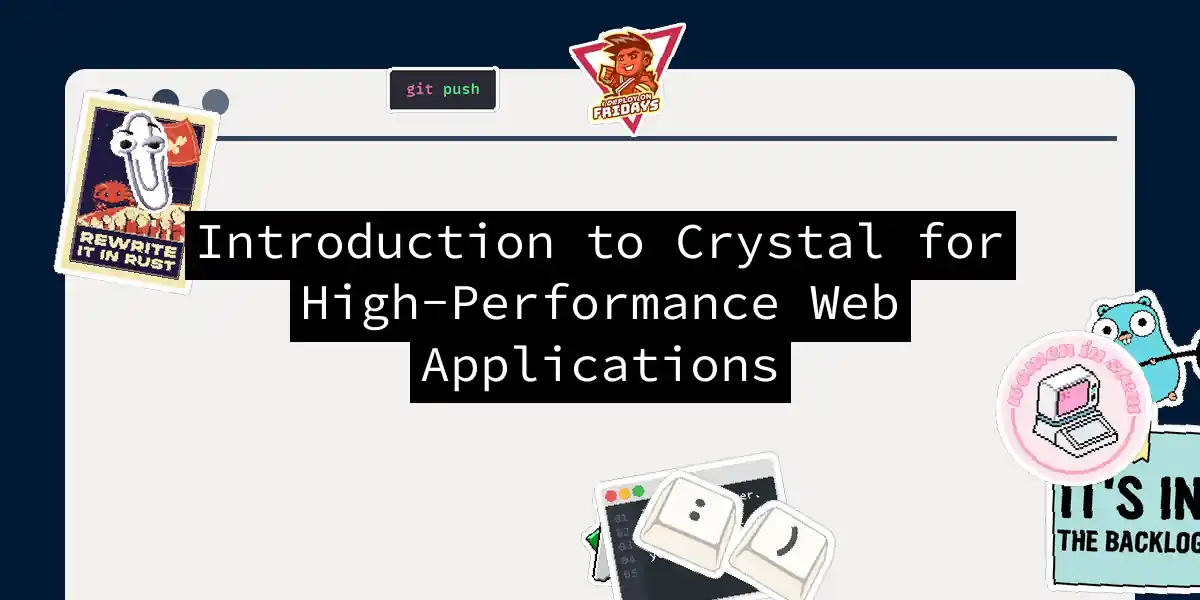Introduction to Crystal
Crystal is a high-level, object-oriented programming language that combines the elegance of Ruby with the performance of compiled languages like C++. It’s designed to be efficient, type-safe, and easy to use, making it an excellent choice for developing high-performance web applications. Crystal’s syntax is similar to Ruby’s, but it compiles to native code using the LLVM backend, providing significant speed improvements over Ruby[1].
Key Features of Crystal
- Static Type Inference: Crystal uses advanced global type inference, allowing developers to write code without explicitly defining types. This feature makes it feel like a scripting language while maintaining the benefits of static typing.
- Concurrency Model: Inspired by Communicating Sequential Processes (CSP), Crystal supports lightweight fibers and channels for efficient concurrency management.
- Macros and Generics: Crystal includes a powerful macro system and supports generics, enabling flexible and reusable code.
- Garbage Collection: It features automated garbage collection with a Boehm collector.
Setting Up Crystal
To start with Crystal, you’ll need to install it on your system. Here’s how you can do it:
- Download and Install Crystal: Visit the official Crystal website and follow the installation instructions for your operating system.
- Verify Installation: Open a terminal and run
crystal --versionto ensure Crystal is installed correctly.
Building a Simple Web Server with Crystal
Crystal provides a built-in HTTP server module that makes it easy to create web applications. Here’s a simple example:
require "http/server"
server = HTTP::Server.new do |context|
context.response.content_type = "text/plain"
context.response.print "Hello world The time is #{Time.local}"
end
server.bind_tcp("0.0.0.0", 8080)
puts "Listening on http://0.0.0.0:8080"
server.listen
This code sets up a basic HTTP server that responds with a plain text message.
Web Frameworks for Crystal
Crystal has several web frameworks that make building web applications more efficient and enjoyable. Let’s explore a few of them:
Marten Framework
Marten is a pragmatic web framework that emphasizes simplicity and productivity. It adheres to the “batteries included” philosophy, providing features like ORM, migrations, and security mechanisms out of the box[2].
Example with Marten
Here’s how you can define a model and a handler in Marten:
class Article < Marten::Model
field :id, :big_int, primary_key: true, auto: true
field :title, :string, max_size: 128
field :content, :text
field :author, :many_to_one, to: User
end
class ArticleListHandler < Marten::Handler
def get
render "articles/list.html", { articles: Article.all }
end
end
Lucky Framework
Lucky is another popular framework known for its speed and compile-time error detection. It uses Action classes to handle HTTP requests and provides features like authentication and asset management[3].
Example with Lucky
Here’s an example of how to define an action in Lucky:
class Api::Users::Show < ApiAction
get "/api/users/:user_id" do
json user_json
end
private def user_json
user = UserQuery.find(user_id)
{name: user.name, email: user.email}
end
end
Amber Framework
Amber is a fast and simple framework that supports MVC conventions and includes tools for security and performance optimization[5].
Example with Amber
Amber uses generators to quickly scaffold new projects. Here’s a basic example of how to use Amber:
# Use Amber CLI to generate a new project
# amber new my_app
# Define a model
class User < Amber::Model::Base
field name : String
field email : String
end
# Define a controller
class UsersController < ApplicationController
def index
users = User.all
render json: users
end
end
Concurrency in Crystal
Crystal’s concurrency model is based on lightweight fibers and channels, inspired by Go. This allows for efficient communication between different parts of your application.
Example of Concurrency
Here’s a simple example of using channels for concurrency:
channel = Channel(Int32).new
spawn do
puts "Before first send"
channel.send(1)
puts "Before second send"
channel.send(2)
end
puts "Before first receive"
value = channel.receive
puts value # => 1
puts "Before second receive"
value = channel.receive
puts value # => 2
This code demonstrates how to use channels to communicate between fibers.
Sequence Diagram for Concurrency
Here’s a sequence diagram illustrating the flow of communication between fibers using channels:
Why Choose Crystal?
Crystal offers several advantages for web development:
- Performance: It compiles to native code, providing performance comparable to C++.
- Type Safety: Static typing helps catch errors at compile time, reducing runtime bugs.
- Concurrency: Efficient concurrency support makes it suitable for high-performance applications.
- Community: Although smaller compared to other languages, the Crystal community is friendly and active.
However, Crystal also has some drawbacks, such as a smaller community and limited documentation compared to more established languages.
Conclusion
Crystal is a powerful tool for building high-performance web applications. Its unique blend of Ruby-like syntax and compiled performance makes it an attractive choice for developers looking to leverage the strengths of both worlds. With frameworks like Marten, Lucky, and Amber, Crystal provides a robust ecosystem for web development. Whether you’re building a simple web server or a complex web application, Crystal is definitely worth considering.
